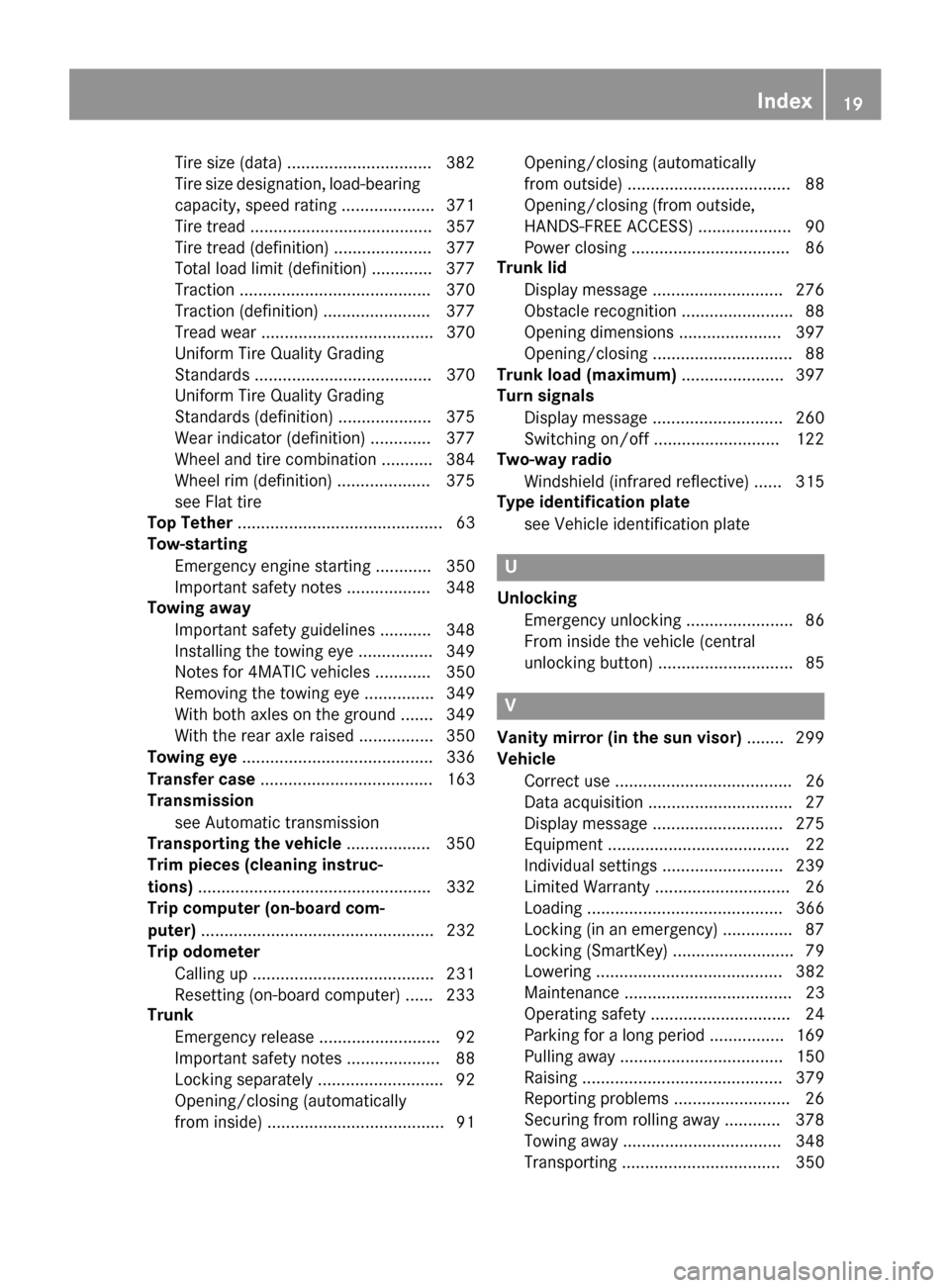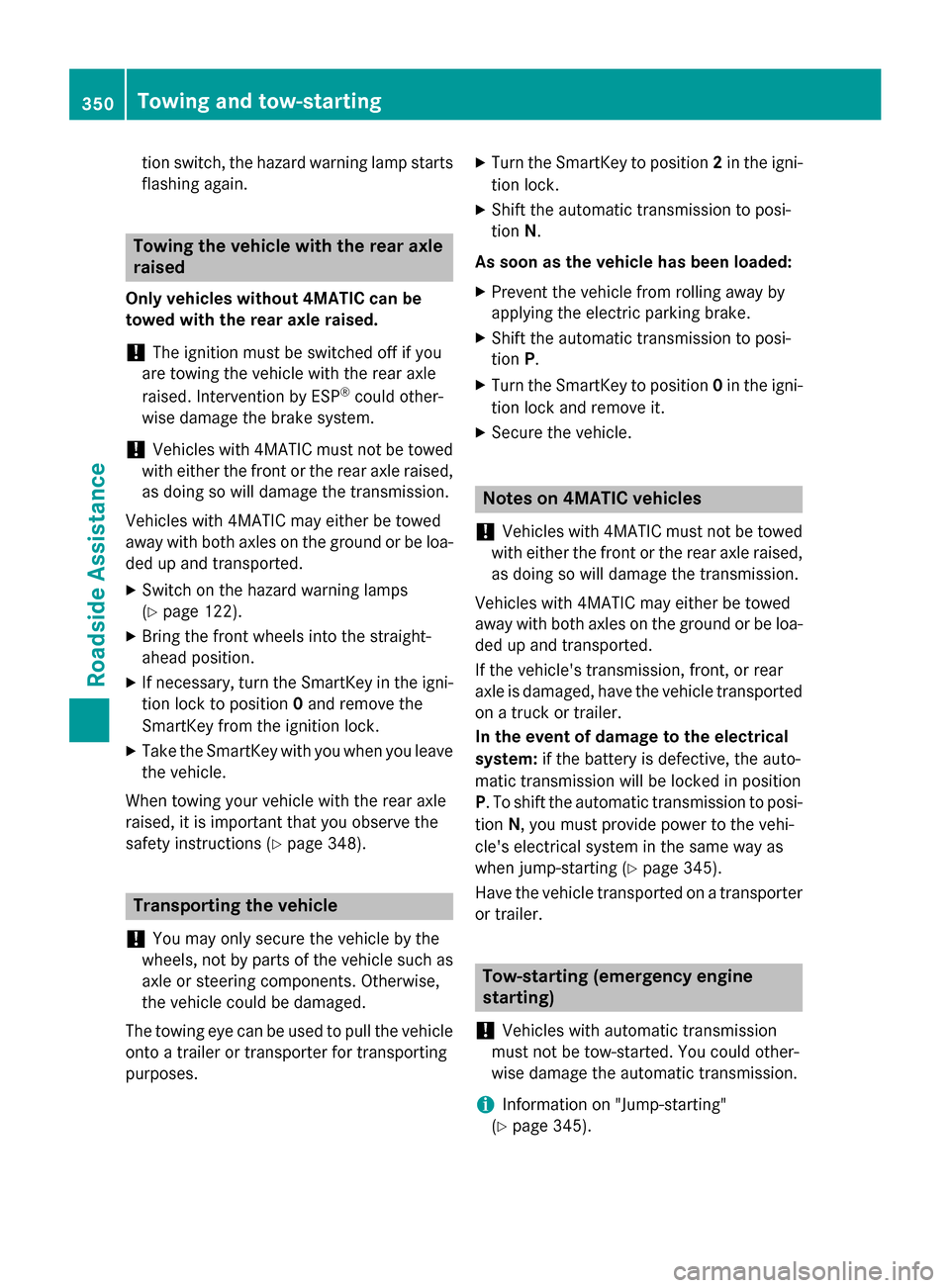emergency towing MERCEDES-BENZ S-Class COUPE 2015 C217 Owner's Manual
[x] Cancel search | Manufacturer: MERCEDES-BENZ, Model Year: 2015, Model line: S-Class COUPE, Model: MERCEDES-BENZ S-Class COUPE 2015 C217Pages: 402, PDF Size: 7.3 MB
Page 21 of 402

Tire size (data) ...............................3
82
Tire size designation, load-bearing capacity, speed rating .................... 371
Tire tread ....................................... 357
Tire tread (definition) ..................... 377
Total load limit (definition) ............. 377
Traction ......................................... 370
Traction (definition) ....................... 377
Tread wea r..................................... 370
Uniform Tire Quality Grading
Standards ...................................... 370
Uniform Tire Quality Grading
Standards (definition) .................... 375
Wear indicator (definition) ............. 377
Wheel and tire combination ........... 384
Wheel rim (definition) .................... 375
see Flat tire
Top Tether ............................................ 63
Tow-starting
Emergency engine starting ............ 350
Important safety notes .................. 348
Towing away
Important safety guidelines ........... 348
Installing the towing eye ................ 349
Notes for 4MATIC vehicles ............ 350
Removing the towing eye ............... 349
With both axles on the ground ....... 349
With the rear axle raised ................ 350
Towing eye ......................................... 336
Transfer case ..................................... 163
Transmission
see Automatic transmission
Transporting the vehicle .................. 350
Trim pieces (cleaning instruc-
tions) .................................................. 332
Trip computer (on-board com-
puter) .................................................. 232
Trip odometer
Calling up ....................................... 231
Resetting (on-board computer) ...... 233
Trunk
Emergency release .......................... 92
Important safety notes .................... 88
Locking separately ........................... 92
Opening/closing (automatically
from inside) ...................................... 91 Opening/closing (automatically
from outside) ................................... 88
Opening/closing (from outside,
HANDS-FREE ACCESS) .................... 90
Power closing .................................. 86
Trunk lid
Display message ............................ 276
Obstacle recognition ........................ 88
Opening dimensions ...................... 397
Opening/closing .............................. 88
Trunk load (maximum) ...................... 397
Turn signals
Display message ............................ 260
Switching on/of f........................... 122
Two-way radio
Windshield (infrared reflective) ...... 315
Type identification plate
see Vehicle identification plate U
Unlocking Emergency unlocking ....................... 86
From inside the vehicle (central
unlocking button) ............................. 85 V
Vanity mirror (in the sun visor) ........ 299
Vehicle
Correct use ...................................... 26
Data acquisition ............................... 27
Display message ............................ 275
Equipment ....................................... 22
Individual settings .......................... 239
Limited Warranty ............................. 26
Loading .......................................... 366
Locking (in an emergency) ............... 87
Locking (SmartKey) .......................... 79
Lowering ........................................ 382
Maintenance .................................... 23
Operating safety .............................. 24
Parking for a long period ................ 169
Pulling away ................................... 150
Raising ........................................... 379
Reporting problems ......................... 26
Securing from rolling away ............ 378
Towing away .................................. 348
Transporting .................................. 350 Index
19
Page 352 of 402

tion switch, the hazard warning lamp starts
flashing again. Towing the vehicle with the rear axle
raised
Only vehicles without 4MATIC can be
towed with the rear axle raised.
! The ignition must be switched off if you
are towing the vehicle with the rear axle
raised. Intervention by ESP ®
could other-
wise damage the brake system.
! Vehicles with 4MATIC must not be towed
with either the front or the rear axle raised,
as doing so will damage the transmission.
Vehicles with 4MATIC may either be towed
away with both axles on the ground or be loa- ded up and transported.
X Switch on the hazard warning lamps
(Y page 122).
X Bring the front wheels into the straight-
ahead position.
X If necessary, turn the SmartKey in the igni-
tion lock to position 0and remove the
SmartKey from the ignition lock.
X Take the SmartKey with you when you leave
the vehicle.
When towing your vehicle with the rear axle
raised, it is important that you observe the
safety instructions (Y page 348).Transporting the vehicle
! You may only secure the vehicle by the
wheels, not by parts of the vehicle such as axle or steering components. Otherwise,
the vehicle could be damaged.
The towing eye can be used to pull the vehicle
onto a trailer or transporter for transporting
purposes. X
Turn the SmartKey to position 2in the igni-
tion lock.
X Shift the automatic transmission to posi-
tion N.
As soon as the vehicle has been loaded:
X Prevent the vehicle from rolling away by
applying the electric parking brake.
X Shift the automatic transmission to posi-
tion P.
X Turn the SmartKey to position 0in the igni-
tion lock and remove it.
X Secure the vehicle. Notes on 4MATIC vehicles
! Vehicles with 4MATIC must not be towed
with either the front or the rear axle raised,
as doing so will damage the transmission.
Vehicles with 4MATIC may either be towed
away with both axles on the ground or be loa- ded up and transported.
If the vehicle's transmission, front, or rear
axle is damaged, have the vehicle transported
on a truck or trailer.
In the event of damage to the electrical
system: if the battery is defective, the auto-
matic transmission will be locked in position
P. To shift the automatic transmission to posi-
tion N, you must provide power to the vehi-
cle's electrical system in the same way as
when jump-starting (Y page 345).
Have the vehicle transported on a transporter
or trailer. Tow-starting (emergency engine
starting)
! Vehicles with automatic transmission
must not be tow-started. You could other-
wise damage the automatic transmission.
i Information on "Jump-starting"
(Y page 345). 350
Towing and tow-startingRoadside
Assistance